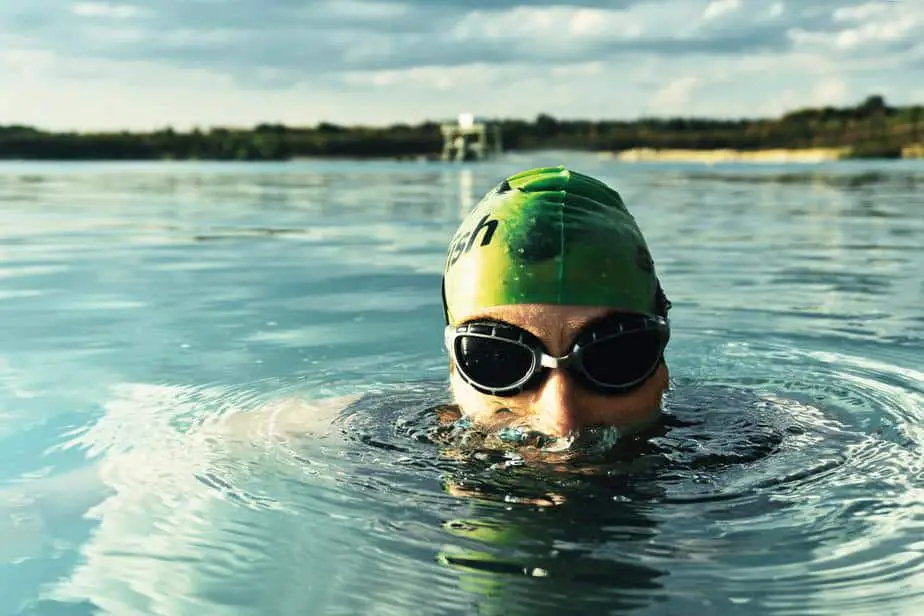Caps are essential for competitive swimmers because they make the wearer more hydrodynamic. They are amazing until they start sliding off during practice, or worse, during a race. A swim cap that doesn’t stay on your head is worse than useless; it would be an actual hindrance.
Most people don’t have this problem, but for the people that do, it can really take the fun out of swimming. Unfortunately, due to the wide variance in swim caps and head sizes (and shapes), it can be hard to determine who will struggle with this problem and who will be lucky enough to never encounter this problem.
Thankfully, while there are no guarantees that a swim cap will fit you out of the box, there are numerous options you can try to keep a swim cap from slipping off your head. To list a few, you can try to get a different swim cap that is a different size or made with different materials, you can learn how to put it on differently, or you can use products to help keep it in place.
In this article, we will be exploring the most common reasons why your swim cap keeps slipping off, and how to avoid these mistakes in the first place. Let’s dive in.
Top reasons why your swim cap keeps slipping off

You’re wearing the wrong type of cap
As weird as it is to hear, you might be wearing the wrong type of cap for your head. “But aren’t swim caps one-size-fits-all? How difficult could it be to find a swim cap that fits?”, you might be wondering.
First off, swim caps aren’t one-size-fits-all, and we’ll talk more about this in a dedicated section. Second, swim caps are made from different materials such as silicone, latex, Lycra, or neoprene just to name a few, and you might need to switch to a different cap.
The most common caps are silicone or latex caps because they offer a tighter fit and most of the time they just work out of the box. That said, silicone and latex caps can also fall off, and some people find them uncomfortable so they don’t want to wear them in the first place.
Lycra swim caps are also popular because of how soft they are, but unfortunately that is a contributing factor to sliding off your head. For this reason, they are often used for water aerobics, therapy, or recreational swimming, instead of swimming laps.
Another mistake people make is assuming that the sizing is uniform across all brands. A large size in one brand can be slightly different to a large in another brand, so you will have to pay close attention to the exact measurements, not the labeling. When you find a brand that fits you, it’s a good idea to stick with that brand for future purchases.
You’re using too much conditioner or product
You may have heard of or personally experienced a swim cap that tugs painfully and uncomfortably on your hair. To address this issue, many swimmers put conditioner in their hair (or some other product that decreases friction).
While this may fix the issue for some, it can potentially introduce another issue for others, which is that your swim cap can slip off sometimes. It might even be the hair gel or shampoo that makes hair slippery.
To prevent this, thoroughly rinse your hair to get rid of any excess product before wearing the swim cap. Saturating your hair with water should be enough to prevent tugging, and you can also comb your hair to get rid of any knots beforehand. You can also rinse the cap with water in case there is any lingering product on the cap itself.
Moisturizer is making your skin slippery
In a similar vein to the point above, if you happen to have moisturizer on your face, this can reduce friction and make it difficult for the swim cap to have a solid grip on your head.
Prior to wearing a swim cap, wash off the moisturizer, lotion, or other product from your face, particularly your forehead where the swim cap will be in direct contact with, to help the cap stay on your head.
Not washing off moisturizer can also cause your goggles to slide around and not seal properly on your face, so this can potentially solve another problem you could face.
You could also try using other products that are compatible with your swim cap and goggles where you can leave it on without affecting your swim gear. Though, if you are in doubt, just rinse off all product from your face and hair.
The swim cap is not the right size
This is an issue that is simultaneously the obvious problem, yet it’s hard for the layperson to determine if it’s truly the case. Inexperienced swimmers will not have a point of reference for what is considered the “right” fit, and there are other factors that could make an appropriate sized swim cap slip off, so it can be confusing.
There is also a lot of variance in the shape of people’s heads and how long their hair is. It could be that you have an exceptionally wide or narrow head, or that your hair is unusually long and your swim cap is failing to properly cover it up.
If the problem is your long hair, look specifically for swim caps for long hair. Long hair caps are extra material and stretchier than other caps to help cover your ponytail or bun better.
As for head shape and size problems, we would like to remind you that swim caps are not one-size-fits-all. You may have to shop around and try different brands to get the best fit. That said, if a cap is too small, check that it’s not a youth cap.
Conversely, if you have a small head and find adult swim caps too large, try a youth cap to see if it fits you better.
You’re wearing the cap wrong
It’s not easy to put on a swim cap properly when you’re starting out, and a cap improperly worn can slide off unexpectedly. Even experienced swimmers can mess it up sometimes, but at least they have coaches or teammates to help them. If you’re on your own, what can you do?
Some people have painstakingly developed their own surefire method to wear a swim cap after lots of trial and error, but even that may only work specifically for that person. You may have to go through your own arduous trials before you come up with your own method.
Here’s our advice on this matter. Pay close attention to the swim cap’s seam which should go down the center of your head (from the front to the back of your head), not side to side. Most logos are found on the side of the cap, so if yours is on the front or back, you’re wearing it wrong.
This next point is up for debate, but you should wear the swim cap over your ears, at least partially. If you are pushing your swim cap up specifically so that your ears are not covered, then that is an area where water could easily rush in and push the cap off as you’re swimming laps.
Your hair placement is off

If you are bald or have short hair, this is not an issue for you. However, people with long hair should obviously tie their hair up in a ponytail or bun. What many fail to account for is that their hair will get pulled down by the cap when they put it on, changing the position from what they are used to.
You may also find that the placement of your ponytail or bun is interfering with how the cap is sealing against your head. If you are not using a long hair cap and you have exceptionally long hair, there is a good chance that your cap will not stretch wide enough to cover your hair.
In the event that your cap is long enough, then the issue may lie with the current placement of your bun or ponytail. You can try tying it up higher, lower, closer to the middle, and so on until you find a placement that works for you.
Keep in mind that it’s possible to mess up the positioning of your cap if you try to adjust your cap and hair too much after the cap is worn. It’s best to keep adjustments to a minimum, otherwise you could loosen the cap and have it slide off while swimming.
Also take into account the placement of your goggle straps once you’ve adjusted your hair. Your bun or ponytail could interfere with the strap position and you will either have to adjust the strap placement or your hair placement.
Air bubbles in the cap are causing a bad fit
Similar to how you should squeeze out any excess air in a zip bag before you zip it, when you put on your swim cap, make sure all of the air is out. This is important not just for keeping it from sliding off your head, but for streamlining your head and reducing drag. Even just a small air pocket can greatly increase the chances of a swim cap sliding off.
To squeeze the air bubble out, press your hands down on your swim cap to ensure that the cap fits snug against your scalp. You can also use this time to make some minor adjustments if you feel your hair placement is a little uncomfortable.
By wetting your cap prior to putting it on, the material will stick better to your head and will mold to the shape of your head when you press it down.
The next time you see swimmers patting their head, you’ll know that they are just trying to squeeze out the air bubbles, not hitting themselves.
You performed a bad dive
If you perform a bad dive or you just did too many dives then eventually your cap can fall off. This shouldn’t be surprising, considering the rush of air and water you’ll experience when diving. Combine this with some of the other issues above, such as air pockets or a bad fit, and you have a recipe for your swim cap sliding off.
To avoid this, you have to first ensure the other problems aren’t affecting you. Then you must pay attention to your head position when you dive. There isn’t a right or wrong way per se, so you will just have to try out different positions and see which works best for you.
You’re swimming with your head up
In a similar vein to the above, the way that you are swimming can potentially cause your swim cap to slide off. Swimming with your head up is a common mistake because you are used to seeing what’s in front of you but it’s not where you should be looking.
For example, in the freestyle or butterfly stroke, you are advised to look at the bottom of the pool, and for backstroke, you are advised to look at the ceiling. This will let the crown of your head act as a leading edge that forces the water to push the cap onto the scalp, and will also make you more hydrodynamic.
When you look forward, this does not occur. Instead, your face will increase drag, and the water will flow across your face and push the cap off your head instead of toward it. It may not happen right away, but over time the swim cap can completely slide off your head.
Looking up when you swim is a bad habit in general, with the worst issue being that you are not swimming efficiently. However, your cap sliding off is another downside to swimming with your head up.
You’re not wearing goggles over your swim cap

This may be a controversial recommendation, as there is a camp of people who prefer to wear goggles under their swim cap, but wearing them over your swim cap can help keep it in place.
At the end of the day, it’s all personal preference because both seem to work fairly well. It’s like the debate between whether you should cover your ears with your swim cap or leave them uncovered. Even at the professional level, there are swimmers who have different preferences, so just do whatever makes you happy.
You didn’t double up
In a race where you absolutely don’t want to have a swim cap malfunction, it’s not unusual to wear two caps. The first cap is worn as normal, but the second cap is worn over the goggle straps and the first cap.
For the first cap, competitive swimmers will wear a latex cap as the inner layer because it has much more grip for the goggle straps to cling onto. The second cap will be a silicon cap because it has the least drag underwater.
By layering your swim caps, you decrease the likelihood of your goggles or your first swim cap sliding off during a race. You will still be as hydrodynamic as if you had one cap and you can rest assured that your cap and goggles are secured.
Parting words
Can you believe how much we can write on the topic of swim caps and how to prevent it from slipping off your head? Alas, this seemingly simple task has perplexed many swimmers when they are starting out, so there is much to be said on how to do it properly.
While it isn’t exactly rocket science, putting on a swim cap properly such that it doesn’t fall off or cause discomfort is something that requires lots of trial and error. The tips we provided in this article can help you speed up this otherwise arduous process.
Once you have found a technique that works for you with a high degree of success, keep practicing until you’ve perfected it. Then you can reliably put on a swim cap each time without any issues.
Additionally, you should pay attention to how you take care of your swim cap so that you can get the most benefit out of it. Well-kept caps can last longer and stay on your head better than caps that have been neglected or improperly stored. This will ultimately lead to better results in the pool.
Most of the time, swim caps are damaged when people don’t know how to put them on. They will stretch the cap too much beyond what’s necessary, but in reality it’s just damaging the cap. You can also accidentally puncture the cap. This is especially true if you have long and sharp nails or you have ear piercings.
This post has started to get quite lengthy, so we’ll stop here. We covered the most common reasons why a swim cap can slip off your head and ways to prevent it from happening. Give these tips a try and see if you can quickly come up with a foolproof method to wear a swim cap so that it’s comfortable and won’t slide off your head. Good luck!

